#taiko inoue
Text

Little Guy Party Time!
#my art#digital art#digital arwork#misc. stuff#crossover#fan art#fanart#lbp#lbp fanart#little big planet#sackboy#parappa fanart#parappa the rapper#taiko drum master#taiko no tatsujin#don chan#toro inoue#toro cat#punchy#animal crossing#super monkey ball
1K notes
·
View notes
Text
荘銀タクト鶴岡へ
さぁAUN&HIDE!次は山形!荘銀タクト鶴岡へ。HIDEさんと合流してまたパワーアップした演奏をお届けに行きますよ〜
https://www.min-on.or.jp/play/detail_211022_.html
【料金】全席:¥5,000
【チケットのお求め】・ローソンチケット https://l-tike.com/ ローソン・ミニストップ店頭Loppi[Lコード:21482]・チケットぴあ https://t.pia.jp/セブンイレブン店頭[Pコード:243-255]・荘銀タクト鶴岡 ☎0235(24)5188
【お問い合わせ】・MIN-ON仙台 ☎022(355)4772平日:10:00~17:00(営業時間は変更となる場合がございます)
※小学生未満のお子様(乳幼児)のご入場は固くお断りいたします。

View On WordPress
0 notes
Text
╰┈➤ @goddessrisen got healed !


In the heart of NOCTURNAL summer, upon a bench ancient and worn, two entities of disparate essence did chance encounter under the moon's omnipotent scrutiny. The ambience hung rich with the potent aroma of night-blooming florals, carried by zephyrs communicating occult messages through the foliage above. In the moon's argent illumination, shadows performed their capricious dance, spinning about the magnificent trunks of time-scarred arboreal sentinels.
Inoue, cocooned in the moon's tranquil radiance, her ocular orbs reflecting its diaphanous effulgence. Her regard was ensnared by the vivacity of a festival near at hand—a PHANTASMAGORIA of hue and sonance—life's very exuberance pulsating in accordance with the taiko's tribal cadence. The drums' rhythm resonated within her being—a second pulse that anchored her to this fluctuating conjunction of space and chronology.
Her companion, a silhouette accentuated by lunar artistry, had a demeanor complemented by soft lunar mercy. A cipher concealed in the nocturnal rustle of her attire—a summer dress—and enunciated by playful zephyrs. Roseate margins curled in a gesture of invitation, yet mystery persisted. Orihime’s utterance emerged as a dulcet breath woven into the night air. “Are you a foreigner? I never saw you around here.”

3 notes
·
View notes
Text
#365DaysOfVGM Day 58:
Bona Inoue - Uso-uso Doki (Taiko no Tatsujin: Momoiro Version [2013])
The eerie sounds at start & end, followed by lyrics about moving on from sadness/trauma, is likely to resonate as well as the fun Piano & Bass!
(Length: 2+ minutes)
youtube
1 note
·
View note
Audio
5 notes
·
View notes
Note
Ken Masters
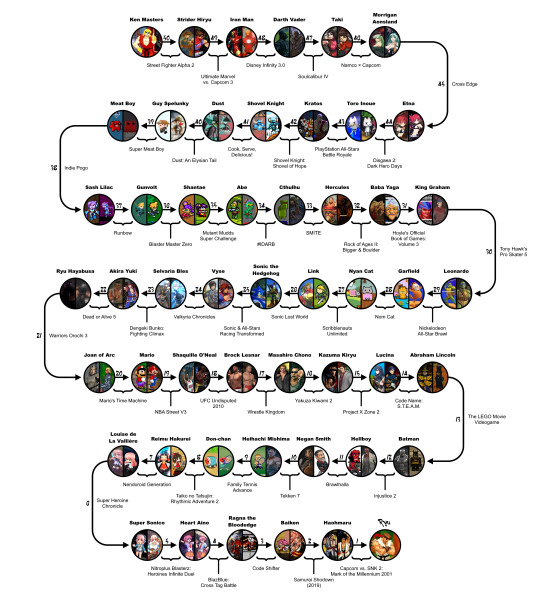
Ken Masters has a Ryu Number of 50.
(clarification below)
First things first; yes, obviously, Ken Masters has an actual Ryu Number of 1.
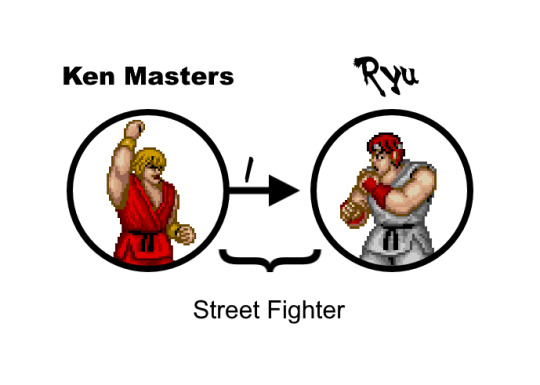
This April Fools’ post is primarily inspired by this tweet from the Twitter account, where Ken’s Ryu Number was maximized to 21 under the limitation of one character per franchise to avoid trivial extensions.

So, naturally, when @jenni-e-doodles sent in the above tongue-in-cheek ask also in August of 2021, I decided to take a stab at it myself with the justification of April Fools’ and the additional limitation of one link per franchise, partially to avoid bouncing back and forth between entries of crossover series and partially just to see if I could.
Admittedly, I did stretch the definition of "franchise", especially with regard to real life people. I generally interpreted that as "sphere of relevance", and even then by far the dodgiest is probably not counting Brock Lesnar and Masahiro Chono under one category of professional wrestling. (In my defense, they had exactly one match together, even if said match was a three-way for the IWGP Heavyweight Championship that Lesnar won as his debut, and Lesnar's brief but notable stint in UFC makes him relevant in the MMA sphere, which cannot be said for Chono, even when that actually was true for some of his NJPW colleagues.)
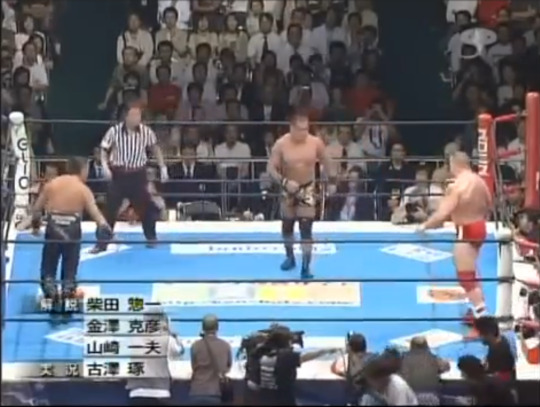
I also tried to use links that had no noteworthy caveats at all, and came real close: Code Shifter's a bit iffy since all the characters in question are technically data for an in-universe game called Colorful Fighters. The ruling per the Twitter account FAQ is that the eligibility of in-universe media depictions is answered by the question “How lazy is it?”, which probably falls in Code Shifter’s favor since, past the part where it’s explicitly an ArcSys crossover first and foremost, you can outright play Colorful Fighters in Code Shifter.

Still, had I caught this earlier, I probably would have rerouted the whole thing to avoid it. (As it happened, I worked out it that it would probably require rerouting past at least Reimu, which was more effort than I was willing to put in at that point. Oops.)
All in all, I’m quite surprised that I not only hit my initial ambitious goal of 50, but probably had room for a few more. (You might notice a few blog staples are conspicuously missing.) This took an unconscionable amount of effort to plan and put together, but I’m glad it’s resonated as well as it has.
And while it wasn’t my intention in the slightest, I apparently did manage to actually fool at least one person.

So that’s neat, I guess.
In order, the characters used are:
Ken Masters (Street Fighter)
Strider Hiryu (Strider)
Iron Man (Iron Man/Marvel Comics)
Darth Vader (Star Wars)
Taki (Soulcalibur/Soul)
Morrigan Aensland (Darkstalkers)
Etna (Disgaea)
Toro Inoue (Doko Demo Issyo/Sony Interactive Entertainment)
Kratos (God of War)
Shovel Knight (Shovel Knight)
Dust (Dust: An Elysian Tail)
Guy Spelunky (Spelunky)
Meat Boy (Meat Boy)
Sash Lilac (Freedom Planet)
Gunvolt (Gunvolt)
Shantae (Shantae)
Abe (Oddworld)
Cthulhu (Lovecraftian/Cthulhu Mythos)
Hercules (Greek/Roman/Classical mythology)
Baba Yaga (Slavic folklore)
King Graham (King's Quest)
Leonardo (Teenage Mutant Ninja Turtles)
Garfield (Garfield)
Nyan Cat (Internet memes)
Link (The Legend of Zelda)
Sonic the Hedgehog (Sonic the Hedgehog)
Vyse (Skies of Arcadia)
Selvaria Bles (Valkyria Chronicles)
Akira Yuki (Virtua Fighter)
Ryu Hayabusa (Ninja Gaiden)
Joan of Arc (French history)
Mario (Mario)
Shaquille O'Neal (NBA/basketball)
Brock Lesnar (WWE/US professional wrestling/UFC/mixed martial arts)
Masahiro Chono (NJPW/Japanese professional wrestling)
Kazuma Kiryu (Yakuza)
Lucina (Fire Emblem)
Abraham Lincoln (US history)
Batman (Batman/DC Comics)
Hellboy (Hellboy)
Negan Smith (The Walking Dead)
Heihachi Mishima (Tekken)
Don-chan (Taiko no Tatsujin)
Reimu Hakurei (Touhou)
Louise de La Vallière (The Familiar of Zero)
Super Sonico (Nitroplus)
Heart Aino (Arcana Heart)
Ragna the Bloodedge (BlazBlue)
Baiken (Guilty Gear)
Haohmaru (Samurai Shodown)
Ryu (Street Fighter, again)
and the links used are:
Street Fighter Alpha 2 (Street Fighter)
Ultimate Marvel vs. Capcom 3 (Marvel vs. Capcom)
Disney Infinity 3.0 (Disney Infinity/Disney)
Soulcalibur IV (Soulcalibur/Soul)
Namco × Capcom (Namco, Capcom)
Cross Edge
Disgaea 2: Dark Hero Days (Disgaea)
PlayStation All-Stars Battle Royale (Sony Interactive Entertainment)
Shovel Knight: Shovel of Hope (Shovel Knight)
Cook, Serve, Delicious!
Dust: An Elysian Tail
Super Meat Boy (Meat Boy)
Indie Pogo
Runbow
Blaster Master Zero (Blaster Master)
Mutant Mudds Super Challenge (Mutant Mudds)
#IDARB
SMITE
Rock of Ages II: Bigger & Boulder (Rock of Ages)
Hoyle's Official Book of Games: Volume 3 (Hoyle's Official Book of Games)
Tony Hawk's Pro Skater 5 (Tony Hawk)
Nickelodeon All-Star Brawl (Nickelodeon/Nicktoons)
Scribblenauts Unlimited (Scribblenauts)
Sonic Lost World (Sonic the Hedgehog)
Sonic & All-Stars Racing Transformed (Sega All-Stars/Sega)
Valkyria Chronicles
Dengeki Bunko: Fighting Climax (Dengeki Bunko)
Dead or Alive 5 (Dead or Alive)
Warriors Orochi 3 (Warriors Orochi)
Mario's Time Machine (Mario)
NBA Street V3 (NBA)
UFC Undisputed 2010 (UFC)
Wrestle Kingdom (Japanese professional wrestling)
Yakuza Kiwami 2 (Yakuza)
Project X Zone 2 (Project X Zone)
Code Name: S.T.E.A.M.
The LEGO Movie Videogame (LEGO)
Injustice 2 (Injustice/DC Comics)
Brawlhalla
Tekken 7 (Tekken)
Family Tennis Advance (Family Tennis/Family Sports)
Taiko no Tatsujin: Rhythmic Adventure 2 (Taiko no Tatsujin)
Nendoroid Generation (Nendoroids)
Super Heroine Chronicle
Nitroplus Blasterz: Heroines Infinite Duel (Nitroplus)
BlazBlue: Cross Tag Battle (BlazBlue, others)
Code Shifter (Arc System Works)
Samurai Shodown (2019) (Samurai Shodown)
Capcom vs. SNK 2: Mark of the Millennium 2001 (Capcom vs. SNK/Capcom, SNK)
1K notes
·
View notes
Note
What songs do you associate with the Riders the most? This can be from the official OST or songs in general.
I tend to associate Riders very strongly with themes from their show in general, especially image songs specific to their character. And even more so if they're done by the actor of the Rider himself.
I believe I've already done an ask like this before, though I can't seem to find the post anymore. Maybe it was on my original blog... idk.
There are two Riders here that I don't particularly associate with any songs- Haruto and Aruto. I just don't have anything that pops into my head with them. Not even their own OPs, to be honest. Not quite sure why. Also, Ikki, but he's fairly new, tbf.
Tsukasa: Journey through the Decade. Even more so now that Masahiro Inoue did a cover of it.
ShouPhil: Cyclone Effect, specifically the acoustic version. Anyone who watched episode 48 would understand.
Eiji: Time Judged All. Done by Shu Watanabe and Ryousuke Miura. They better use it in the 10 Years After movie or people will riot.
Gentaro: Samurai Strong Style, the theme for Movie War Megamax. It's performed by Kishidan, who would also do the Ghost OP.
Kouta: Ranbu Escalation, the theme for Kiwami Arms aka Fruit Jesus form. Sung by Gaku Sano and Yuataka Kobayashi (Kumon Kaito)
Shinnosuke: Spinning Wheel, the theme for Type Tridoron. Ryoma Takeuchi perfoms it with Taiko Katoono (Chase) and Yu Inaba (Gou).
Takeru: Warera Omou, Yue Ni Warera Ari aka the Ghost OP. I may have teared up a little when they used as the SpectrexBlades ED
Emu: Life is Beautiful. I think pretty much anyone who watched Ex-Aid would agree with me on this.
Sento: Everlasting Sky, the theme for Be the One. It was done by Beverly, who also did the OP for which the movie was named for.
Sougo: Toki no Ouja, which was sung by the demon overlord himself, Sou Okuno. Also the form theme for Grand Zi-O, I believe.
Touma: Rewrite the Story. It's sung by him and the two guys I ship him with, it's the theme for Xross Saber... what's not to love
18 notes
·
View notes
Text
The Harada Dojo where Kondo Isami first learned the sword
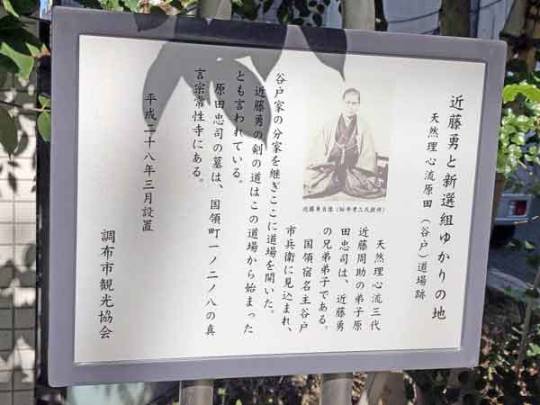
The Harada Dojo is a dojo in Chofu City, where it is said that Kondo Isami learned the Tennen Rishin-ryu for the first time .
It is now an apartment, and there is an information board about Kondo Isami and the dojo next to it.
This post will introduce the remains of the Harada Dojo, which can be said to be the catalyst for the existence of "Kondo Isami".
Directions
Address: 1-30 Kokuryocho, Chofu City
How to get there: 5 minutes walk from Fuda Station on the Keio Line

Map of Harada Dojo Ruins
The ruins of the Harada Dojo where Kondo Isami learned the sword for the first time
Information board at the place where Kondo Isami learned the sword

Harada Tadashi Dojo Ruins
Harada Tadashi opened a Tennen Rishin-ryu dojo in a building that was previously the Kokuryo Inn.
According to one theory, Kondo Isami went to this dojo to learn the Tennen Rishin-ryu.
It is also said that Harada Tadashi saw talent in Kondo Isami and brought him to Kondo Shusuke (who later became the adoptive father of Kondo Isami) .
After losing the battle of Toba-Fushimi, the Shinsengumi changed their name to Koyo Chinbutai and went to Koshu (Yamanashi), passing through the Koshu Kaido road in front of this dojo.
At this time, there is an anecdote that Kondo Isami stopped by at the Harada Dojo to greet his former teacher.
Harada Dojo Site Information Board Location

The information board for the remains of the Harada Dojo is in an inconspicuous place
It is about a 5-minute walk from Fuda Station on the Keio Line .
In front of an apartment called Fermier, it doesn't stand out, so you can overlook it easily.
It was lined up with the signboard of "Tanito Farm".
Next to the condominium is the road to Tanito Farm, and next to it is a children's English school called Kids Duo.

The scenery opposite of the Harada Dojo ruins
There is a "Shinju" and a chicken specialty store diagonally opposite.
Who was Harada Tadashi who taught Kondo Isami the sword?
Harada Tadashi was a disciple of the Tennen Rishin-ryu and a student of Kondo Shusuke. He was an assistant instructor for Kondo Shusuke at the Shieikan.
The Kojima family in Machida also recorded that Harada Tadashi often arrived for practice before Kondo Isami arrived.
The dojo used to be the Kokuryo Inn, owned by a branch of the Tanito family which Harada Tadashi belonged to.
Kondo Isami came here, and Harada Tadashi discovered his talent and brought him to Kondo Shusuke.
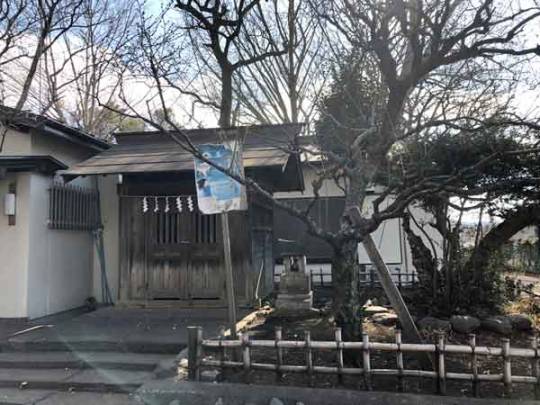
Near the Tenjin Shrine in Fuchu, where there was an outdoor tournament to announce Kondo Isami's succession as the master of the Tennen Rishin-ryu
Later, when Kondo Isami held an outdoor tournament to announce his succession as the master of the Tennen Rishin-ryu, Harada Tadashi participated in the main tent as a metsuke (a role that observed and reported battle movements).
In the main team were Kondo Isami with the role of commander, Okita Rintaro (the husband of Okita Souji's sister) as bugyō (military commisioner), Okita Souji in the role of taiko drums, and Inoue Genzaburo in the role of kane gongs.
Hijikata Toshizo and Sannan Keisuke were in the Red Team and were fighting against the White Team led by Sato Hikogoro.
As a high-ranking disciple of the Shieikan, and as an assistant instructor to the previous master, Kondo Shusuke, it seems that he had crossed swords not only with Kondo Isami, but also with the other members who would later become the Shinsengumi.
Harada Tadashi died in Meiji 26, and his grave is located in the graveyard of the Tanito family at Jyosei-ji Temple (1-2-8, Kokuryo-cho, Chofu City) near the site of the dojo.
9 notes
·
View notes
Text
Animation Night 81 - Mari Okada
Hiii friends! I’ve recovered from yesterday’s Japanese bakery/Taiko no Tatsujin exploits - more America Observations on that in a bit - and it’s time for Animation ‘Night’. Unfortunately being on California time means we’re slipping a lot compared to ‘7pm UK time’ - please forgive me! I slept like a log last night but still woke up late!!
Tonight we’re going to be visiting the work of Mari Okada, who is one of the most prolific screenwriters in anime and, in 2018, made a very striking step into direction with Maquia: When The Promised Flower Blooms. I’m gonna post a picture of her bc omg look at this dramatic pose. Maquia caught my eye thanks to a recommendation by animator Dong Chang, but digging in, it’s surrounded by some pretty interesting stories!

Maquia is notable for being a major turn in the history of PA Works towards cultivating younger animators, as kVin documented at the time with a couple of excellent articles on Sakugablog. This came two years in the wake of an unfortunate controversy about the studio in which an inbetweener talked about shit pay and bizarre treatment like charging inbetweeners a desk fee if they failed to graduate to key animation in a few years. As kVin pointed out, despite all that PA Works is unfortunately still better than average by the miserable standards of the anime industry.
Since then, it seems like - as far as this disconnected outsider can discern - they started making a genuine effort to sort some of this shit out, with the production of Maquia representing the fruit of several new initiatives to push the studio towards the KyoAni model: salaried positions for animators and an explicit training program led by veteran animator Toshiyuki Inoue. Some of the fruits of that training program were made available publicly in English - see here for Inoue’s notes on walk cycles, and on PA works site are some fantastically useful examples of animation of fire and walking which I’ve definitely found very useful. In addition to instructing these younger animators, Inoue provided a truly astonishing amount of key animation for the film itself:
Personal bonds dating back to the days where P.A. Works staff would cooperate with Production I.G bring him to the studio to animate special scenes every now and then, but this time around he truly outdid himself. Inoue drew 120 cuts of fully finished key animation, as well as 180 cuts of roughs that were by any sane standards virtually perfect already. On top of that, he drew the layouts for 100 other cuts for Takeshi Honda to finish. About 400 cuts total, meaning way more than your average episode of anime’s worth of nothing but master class work. The thorough consideration that went into every single gesture, as well as the volumetric dragon animation that looks like it shouldn’t be possible without CG support, left everyone in the team speechless. Yes, even Mari Okada!
and alongside him they brought on a long list of other veterans:
Tadashi Hiramatsu was first contacted to draw storyboards and supervise the animation, but his grasp on this medium as a whole is so firm that extra duties kept getting piled on him, to the point that they had to come up with the role of Core Director to explain just how integral he was to this movie from a technical standpoint. His presence was also an incentive for illustrious acquaintances like Akemi Hayashi to show up to draw beautiful sequences, which only further encouraged other ace animators to show up as well; Takeshi Honda, Hidetsugu Ito, Takaaki Yamashita, Akira Honma, Masahiro Sato, Kazuki Hoshino – the final list of key animators is adorned by many of the names we’ve come to expect from anime’s greatest productions.

What of director Mari Okada herself? Luckily she has published an autobio, parts of which are summarised by Anime News Network, so we can find out a lot about her. Her childhood was characterised by severe bullying, parental abuse and social anxiety that caused her to drop out in middle school; she made it back in on the strength of her writing but continued to struggle. She got some escape after moving to Tokyo to study game writing. But after graduating, she could only find various low-paying writing jobs.
Okada’s start in anime came back in 1998 with largely forgotten Sunrise sci-fi DT Eightron [wiki]:
Through her studies, Okada developed a passion for screenwriting, but found it difficult due to anxieties. Her earliest jobs included creating scenarios for direct-to-video pornography and transcribing interviews for a magazine. It was through this latter job that she met Tetsurō Amino, who asked her to contribute some of her ideas for the plot of DT Eightron. She went on to write the script for five episodes, and the connection with Amino helped in kickstarting her career.
Shortly after this, she sent Amino a story for an original anime project called The World Outside, based on a childhood experience of being threatened by her mother’s boyfriend. Though this never got made, writing it was a cathartic moment for her and informed a lot of her later work.
She continued to take a huge list of anime jobs, slowly climbing from the screenwriting position to the more senior role of ‘series composition’, i.e. a senior scriptwriter whose job is to help the director plan out the overall arc and major events of the series. ANN write:
Okada is a rare exception among anime screenwriters. Through her various original projects, she has been able to express many deep and personal emotions, something that not many scriptwriters have the freedom to do.
This does not mean that she's had creative control over all the works she's participated in lately. For example, with Mobile Suit Gundam: Iron-Blooded Orphans, director Nagai came up with most of the core ideas, and Okada only became involved with the project a few years after planning for the anime began. (She notes herself that this is the opposite of what her role was like on anohana and The Anthem of the Heart.) Within the industry, she's valued not just for her original stories but for her ability to polish the ideas of her colleagues.
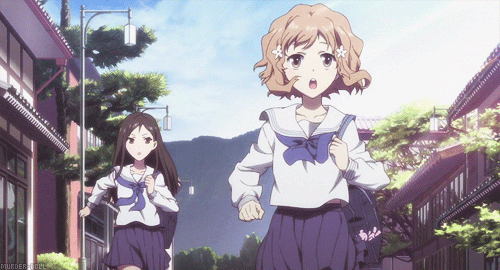
Her rise to fame began with her work on Hana-Saku Iroha, where she revisited The World Outside and chose to write a character based on her mother:
For Okada personally, one of the most important series she handled was Hana-Saku Iroha, where she was assigned a high degree of creative freedom. As she tried to think of ideas, she reread “The World Outside” for the first time in years. By then, Okada was in her thirties, and at last she felt that she could understand her mother's feelings.
So she decided to write her mother into Hana-Saku Iroha.
In the anime, Ohana's mother is a selfish and irresponsible woman. But Okada was sympathetic toward her, understanding that her own mother wished she could have been a free spirit yet felt constrained by her responsibilities.
Inevitably, writing an anime about her mother did little to reconnect them:
The success of Hana-Saku Iroha propelled Okada into fame almost seemingly overnight. But it didn't mend her relationship with her mother, who was always indifferent about Okada's work. When her mother watched Hana-Saku Iroha, she never saw herself in Ohana's mother at all. The only thing she said about the character to Okada was, “That mother is a mess.” She had missed the point entirely.
But it did do a lot for Okada’s own career, and she became an in-demand screenwriter with the opportunity to write some more personal works.

This brings us to Anohana: The Flower We Saw That Day (あの日見た花の名前を僕達はまだ知らない We Still Don’t Know the Name of the Flower We Saw That Day) and The Anthem of the Heart (心が叫びたがってるんだ The Heart Wants To Shout) - both animated at A-1 Pictures.
Anohana is perhaps the most significant for Okada herself, directly based on her experience of self-isolation in childhood. The process of writing it sounds rather harrowing, after the animators decided to base it even more closely on her life:
Some aspects of the production, however, were a bit too confronting for comfort, especially when the production team decided to base the background art on Okada's hometown [Chichibu] and even use her house as reference. Okada's objections only caused arguments and delays in the production, and so she eventually gave in and allowed anohana to be set in Chichibu.
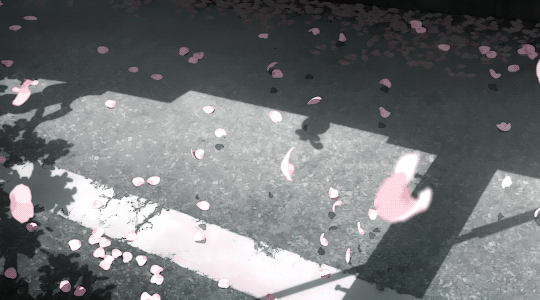
Nevertheless, the project led to overwhelming support from fans in Chichibu, and she returned to create another anime set there. Unfortunately her attempt to find an equal collabration with Nagai led to friction - yet it worked out in the end:
Okada and Nagai couldn't agree on anything, and Okada would constantly backtrack on her ideas. As it turned out, the production flowed more smoothly when she focused on writing the scenario in her own style.
Okada thought that she had written the story with some emotional distance, but after seeing the film animated, she began to cry. Her situation was completely different from the heroine's, but she saw her own emotions represented in the musical scene, when the characters finally allow their true feelings to be heard. She had tried to suppress her own writer's voice in order to allow room for the director, but she had wanted to let her heart shout all along. After watching the film, she realized that.
“I had agonized so much over that project, but in the end it saved me.”
Anthem is notable also for its excellent character animation, conveying all sorts of subtleties of body language as Disgaeamad writes about here. A lot of this can be credited to the skill of key animator Masayoshi Tanaka, who’s known for his work with the later films of Makoto Shinkai (Animation Night 44).
By this point her star had risen to the point that PA Works president Kenji Horikawa proposed a ‘100% Okada anime’, a project that ultimately led to Maquia. Like many of Okada’s works, it’s About Motherhood. kVin writes:
It sings the praises of mothers and their strength with the same unflinching voice that tells us of the visceral pains of motherhood. It humanizes the cast with some of the most evocative character animation that this industry has to offer, and it still has the energy to spare to depict spectacular action and an appropriately dense world. Maquia is thematically tight tale – for the most part – that’s brought to life through one of the most astonishing production efforts that anime’s ever mustered.
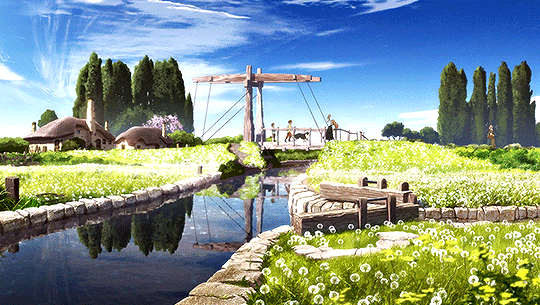
Of course, taking on all the responsibilities of a director is a big jump for even a successful screenwriter; Okada was supported by the experience of assistant director Toshia Shinohara.
So after all this about its production, what is this anime actually about? Maquia turns away from the realistic character drama in modern settings that characterised most of Okada’s previous work, and instead goes for a fantasy world. The eponymous Maquia is a member of a species of immortals called the Iorph who flee genocide at the hands of a neighbouring kingdom. Fleeing the attack, Maquia picks up a child from a destroyed caravan; the film follows the life of Maquia and her adopted son in a variety of locations as she tries to reach the other Iorph diaspora whose immortality is still sought by the royal family. At least that’s the gist I get from the plot summary.
Also there’s loads of dragons involved!
I’m pretty hype to see this film, both for the beautiful character animation and the suitably emotionally wrenching story. For our other slot... As much as I would like to see Ano Hana, the series is too long for Animation Night, and the movie probably won’t fit in the time we have, so we’ll be giving that to Anthem of the Heart.
Animation Night 81 will be starting very shortly at twitch.tv/canmom - hope to see you there!
5 notes
·
View notes
Text

📛 37) 薪水の労。
2022年3月19日より "東京都現代美術館 (Museum Of Contemporary Art Tokyo)" にて 「生誕100年 特撮美術監督 井上泰幸展 (The Art Of Special Effects Production Designer Yasuyuki "Taiko" Inoue)」 という展示会が催されているさうで、昨日 (2022年3月24日) 発表 (および発売) されました Fender社の "Made In Japan Junior Collection Jazz Bass" のことが ちょっぴり気になっている場合ではなかったりします。
1 note
·
View note
Text
Kyōmai
An event of legendary proportions, the Kyōmai is an event that’s seldom been staged over the years, with the last one taking place 19 years ago! Unlike a normal odori, this one takes place at the National Theatre in Tokyo and features the masters of Inoue Kyōmai together on stage. It is one of the rare instances where Yachiyo Inoue will dance in public, and her pieces are always the highlight of the event. Also unlike odori, each performance features different pieces, so you could see all 3 of them and be treated to a new experience!
Kyōmai will be taking place on November 29th and 30th at the National Theatre in Tokyo.
November 29th, 3pm
Piece 1: Kyō No Shiki (京の四季) - The Four Seasons of Kyoto
Dancers: Koeri (小衿), Katsuhana (佳つ花), Mamekinu (まめ衣), Mitsuki (美月), Kohana (小花), Tomoko (朋子), Konami (小なみ), and Mametama (豆珠).
Piece 2: Ashikari (芦刈) - Reed Cutting
Dancer: Inoue Yoko (井上葉子)
Piece 3: Kayō Kami (通う神) - Attendants of The Gods
Dancers: Inoue Takazuru (井上孝鶴) and Inoue Fukue (井上フク愛)
Piece 4: Matsu No Hagoromo (松羽衣) - Hagoromo In The Pines
Dancers:
Fisherman (漁夫): Inoue Terutoyo (井上照豊)
Heavenly Maiden (天人): Inoue Mamechizu (井上豆千鶴)
Piece 5: Azusa (梓) - The Spider Woman
Dancer: Inoue Mamezuru (井上まめ鶴)
Piece 6: Mitsumen Wankyū (三つ面椀久) - The Three Masks of Wankyū
Dancers:
Wankyū (椀久): Inoue Yachiyo (井上八千代)
Omōru (面売): Inoue Yasuko (井上安寿子)
Piece 7: Kuruwa No Nigiwai (廓の賑) - Pieces of The Flourishing District
Pieces: Shichifukujin (七福神) - The Seven Lucky Gods and Shakkyō (石橋) - Stone Bridge
Performers: Mamezuru (まめ鶴), Koman (小萬), Sonomi (そ乃美), Takazuru (孝鶴), Mameka (豆花), Korin (小りん), Fukue (フク愛), Mamechizu (豆千鶴), Terutoyo (照豊), Fukuha (福葉), Mameya (まめ弥), Kokimi (小喜美), Kogiku (小菊), Yukako (有佳子), Ichiyuri (市有里), and Kosen (小扇).
Fue: Mamesuzu (まめ鈴)
Taiko: Satomi (里美) and Mao (真生)
Singers: Komasu (小ます), Komomo (小桃), Yukizono (幸苑), Danka (だん香), and Yoshimame (芳豆)
Shamisen: Emiji (恵美二), Danyū (だん祐), Masuho (ます穂), Kimizuru (君鶴), and Mahori (まほ璃)
November 30th, 11am
Piece 1: Kyō No Shiki (京の四季) - The Four Seasons of Kyoto
Dancers: Koeri (小衿), Katsuhana (佳つ花), Mamekinu (まめ衣), Mitsuki (美月), Kohana (小花), Tomoko (朋子), Konami (小なみ), and Mametama (豆珠)
Piece 2: Mizugakami (水鏡) - Reflection of Water
Dancers: Inoue Korin (井上小りん) and Inoue Mameryō (井上豆涼)
Piece 3: Yumi Nagashi Monogatari (弓流し物語) - Tale of The Arrow Festival
Dancer: Inoue Koman (井上小萬)
Piece 4: Masazuki (正月) - New Year
Dancers: Inoue Mameka (井上豆花), Inoue Fukue (井上フク愛), Inoue Mamechizu (井上豆千鶴), and Inoue Terutoyo (井上照豊)
Piece 5: Chitose No Haru (千歳の春) - 1,000 Years of Spring
Dancer: Inoue Kazue (井上和枝)
Piece 6: Mitsumen Wankyū (三つ面椀久) - The Three Masks of Wankyū
Dancers:
Wankyū (椀久): Inoue Yachiyo (井上八千代)
Omouru (面売): Inoue Yasuko (井上安寿子)
Piece 7: Jūnitsuki (十二月) - Twelve Months
Dancers: Inoue Fukuha (井上福葉), Inoue Satomi (井上里美), Inoue Mameya (井上まめ弥), Inoue Kokimi (井上小喜美), Inoue Kogiku (井上小菊), Inoue Mamesuzu (井上まめ鈴), Inoue Mihoko (井上美帆子), Inoue Koai (井上小愛), Inoue Mao (井上真生), Inoue Yukako (井上有佳子), Inoue Makiko (井上槇子), Inoue Ichiyuri (井上市有里), Inoue Koyō (井上小耀), Inoue Kosen (井上小扇), and Inoue Sayaka (井上紗矢佳).
November 30th, 3pm
Piece 1: Manzai (萬歳) - 10,000 Years
Dancers: Kohana (小花), Tomoko (朋子), Konami (小なみ), Mametama (豆珠), Tatsuha (多都葉), Yuriha (ゆり葉), Mamesaya (豆沙弥), and Katsuharu (佳つ春).
Piece 2: Sangoku Ichi (三国一) - Unparalleled In Asia
Dancers: Inoue Fukuha (井上福葉) and Inoue Satomi (井上里美)
Piece 3: Toribe Yama (鳥辺山) - Mount Toribe
Dancers:
Osome (お染): Inoue Mamehiro (井上豆弘)
Hankurō (半九郎): Inoue Mameka (井上豆花)
Piece 4: Shin Kyō No Shiki (新京の四季) - New Four Seasons of Kyoto
Dancers: Inoue Sonomi (井上そ乃美), Inoue Mameya (井上まめ弥), Inoue Kokimi (井上小喜美), Koeri (小衿), Katsuhana (佳つ花), Mamekinu (まめ衣), and Mitsuki (美月).
Piece 5: Shino (信乃) - Your Fidelity
Dancer: Inoue Yasuko (井上安寿子)
Piece 6: Mushi No Ne (虫の音) - The Sound of Insects
Dancer: Inoue Yachiyo (井上八千代)
Piece 7: Kuruwa No Nigiwai (廓の賑) - Pieces of The Flourishing District
Pieces: Shichifukujin (七福神) - The Seven Lucky Gods and Hana Zukushi (花づくし) - Many Flowers
Performers: Mamezuru (まめ鶴), Koman (小萬), Sonomi (そ乃美), Mamehiro (豆弘), Takazuru (孝鶴), Mameka (豆花), Korin (小りん), Fukue (フク愛), Terutoyo (照豊), Fukuha (福葉), Satomi (里美), Mameya (まめ弥), Kokimi (小喜美), Kogiku (小菊), Mihoko (美帆子), Koai (小愛), Yukako (有佳子), Makiko (槇子), Ichiyuri (市有里), Koyō (小耀), Kosen (小扇), and Sayaka (紗矢佳).
Fue: Mamesuzu (まめ鈴)
Taiko: Mao (真生), Masaki (真咲), and Mameroku (豆六)
Singers: Komasu (小ます), Komomo (小桃), Masuho (ます穂), Danka (だん香), Yukizono (幸苑), and Danmitsu (だん満)
Shamisen: Emiji (恵美二), Danyū (だん祐), Kimizuru (君鶴), Fukunami (福奈美), Mahori (まほ璃), and Emino (恵美乃)
Jikata Performers
Gion Kobu: Komasu (小ます), Emiji (恵美二), Kimiya (君彌), Komomo (小桃), Danyū (だん祐), Mamechiyo (豆千代), Yoshimame (芳豆), Kimizuru (君鶴), Danka (だん香), Fukunami (福奈美), Masuho (ます穂), Yukizono (幸苑), Danmitsu (だん満), Mahori (まほ璃), Emino (恵美乃), Fumino (章乃), Satsuki (紗月), Mamesumi (豆純), Tomichiyo (斗美千代), Masaki (真咲), and Mameroku (豆六).
Outside Performers: Takemoto Komanosuke (竹本駒之助), Tsuruzawa Tsukazu ( 鶴澤津賀寿), Uji Haru (宇治はる), Uji Oto (宇治をと), Umetsuji Rie (梅辻理恵), Koike Noriko (小池典子), Kondo Masako (今藤政子), Kondo Tamami (今藤珠美), and Tōsha Rosen (藤舎呂船).
20 notes
·
View notes
Text
Jzブラッド
AUNJ15yeasライブ〜たくさんの方にお越しいただきありがとうございました。楽しかったですね。懐かしの曲ありであっという間でした〜初披露の新曲「コノハナサクヤヒメ」どうだったかなぁ。かなりの難産でしたが、無事披露出来てホッと一安心。あとは野となれ山となれの気分ですね。それとまたまた新曲制作のくじが大当たりの尾上氏と公平さんです。運がいいのか悪いのか?こんなことある?っていうくらいの運でしたね。ありがたいです。今日はゆっくり休んで明日から新曲制作取り掛かります♪

View On WordPress
1 note
·
View note
Note
... So... It was a bit odd to watch Hibiki at first (no "Henshin!" at all?) but now it's actually really refreshing! Even with Kiriya (I love Nakamura but man what an annoying character) and the lack of taiko drumsticks as weapons (I didn't miss the sword) in this second half! I'm really liking it! Anyway... My dash is just filled with Zi-O posts and now I don't want to finish Hibiki and then go back to the mess that is the usual KR series xD
Also I totally forgot the wiki has a warning about Hibiki and now I know why. Poor Zanki, I think it was really cold that day...
it really is such a unique change of pace, right? god i wish i was rewatching hibiki right now
the fact that you’re still managing to enjoy the 2nd half is nice to hear, it’s certainly not great but there’s still some fun stuff there, y’know? some classic tragic inoue romance and such. zanki-san died with his whole ass out for the sake of his bf... a hero among men ;_;7
3 notes
·
View notes
Text
Japanese Literature Survey Results
Thank you to those of you who participated! You are gentlemen/ladies and scholars! Here are the results for the authors and favorite books you all chose:
Number of Participants: 105
105 out of 3,030 followers participated (so roughly 3.5%). For you beautiful people who actually read and enjoy Japanese literature I love and admire you all! And to you I say (to paraphrase Shakespeare), “The fewer savants, the greater share of honor! We few, we happy few, we band of scholars; for those who peruses literature with me this day are the highest of scholars.”
Geographical Results: Green represents a low concentration of participants, yellow a medium concentration, and red a high concentration.

Authors Read:
Dazai Osamu: 89 readers, 84.8%
Akutagawa Ryuunosuke: 68 readers, 64.8%
Nakahara Chuuya: 51 readers, 48.6%
Natsume Souseki: 45 readers, 42.9%
Edogawa Ranpo: 39 readers, 37.1%
Yosano Akiko: 29 readers, 27.6%
Nakajima Atsushi: 28 readers, 26.7%
Kunikida Doppo: 25 readers, 23.8%
Tanizaki Junichirou: 25 readers, 23.8%
Mori Ogai, 22 readers, 21.0%
Mishima Yukio: 21 readers, 20.0%
Miyazawa Kenji: 21 readers, 20.0%
Oda Sakunosuke: 20 readers, 19.0%
Fukuzawa Yukichi: 14 readers, 13.3%
Sakaguchi Ango: 14 readers, 13.3%
Higuchi Ichiyo: 13 readers, 12.4%
Haruki Murakami: 12 readers, 11.4%
Kajii Motojirou: 10 readers, 9.5%
Ayatsuji Yukito: 8 readers, 7.6%
Tayama Katai: 7 readers, 6.7%
Ibuse Masuji: 6 readers, 5.6%
Ozaki Kouyou: 5 readers, 4.8%
Kawabata Yusanari: 5 readers, 4.8%
Authors with 3 readers: Kenzaburo Oe, Ogawa Yoko, Ueda Akinari, and Yumeno Kyusaku
Authors with 2 readers: Abe Kobo, Enchi Fumiko, Endo Shusaku, Ihara Saikaku, Inoue Yasushi, Matsuo Basho, Murakami Ryu, Murasaki Shikibu, Natsuo Kirino, Sei Shonagon, Suzuki Koji, and Yosa Buson
Authors with 1 reader: Akiyuki Nosaka, Chikamatsu Monzaemon, Eiji Yoshikawa, Futabatei Shimei, Hagiwara Sakutaro, Higashino Keigo, Hiraide Takashi, Kakuta Mitsuyo, Kato Shigeaki, Kazuo Ishiguro, Kenzo Kitakata, Kyogoku Natsuhiko, Masaoka Shiki, Miki Sakamoto, Mineko Iwasaki, Miyamoto Musashi, Miyu Matsuda, Nakagami Kenji, Nanao Sakaki, Sawako Ariyoshi, Shiba Ryotaro, Shiga Naoya, Takami Koshun, Takuboku Ishikawa, Yoshimoto Banana, and Yusuke Kishi
Favorite Literary Work:
No Longer Human by Dazai Osamu: 37 readers
”Hell Screen” by Akutagawa Ryuunosuke: 3 readers
Kokoro by Natsume Souseki: 3 readers
The Setting Sun by Dazai Osamu: 3 readers
I am a Cat by Natsume Souseki: 2 readers
Kafka on the Shore by Haruki Murakami: 2 readers
Norwegian Wood by Haruki Murakami: 2 readers
“Rashoumon” by Akutagawa Ryuunosuke: 2 readers
“River of Stars” by Yosano Akiko: 2 readers
“Spinning Gears” by Akutagawa Ryuunosuke: 2 readers
Vita Sexualis by Mori Ogai: 2 readers
A Fool’s Life by Akutagawa Ryuunosuke: 1 reader
After Dark by Haruki Murakami: 1 reader
Another by Ayatsuji Yukito: 1 reader
“Blue Bamboo” by Dazai Osamu: 1 reader
Chinmoku Hakubutsukan by Ogawa Yoko: 1 reader
“For the Tainted Sorrow” by Nakahara Chuuya: 1 reader
Genii Monogatari by Murasaki Shikoku: 1 reader
Kusamakura by Natsume Souseki: 1 reader
Kyogen no Kami by Dazai Osamu: 1 reader
“Night on the Galactic Railroad” by Miyazawa Kenji: 1 reader
“On Love and Beauty” by Dazai Osamu: 1 reader
“Otsugomori” by Higuchi Ichiyo: 1 reader
Spring Snow by Mishima Yukio: 1 reader
Taiko by Eiji Yoshiwara: 1 reader
“Takekurabe” by Higuchi Ichiyo: 1 reader
Ten Nights of Dreams by Natsume Souseki: 1 reader
The Cage by Kenzo Kitakata: 1 reader
The Early Cases of Akechi Kogoro by Edogawa Ranpo: 1 reader
The Guest Cat by Hiraide Takashi: 1 reader
The House of Sleeping Beauties by Kawabata Yusanari: 1 reader
“The Moon over the Mountain” by Nakajima Atsushi: 1 reader
The Pillow Book by Sei Shonagon: 1 reader
“The State of the Times” by Oda Sakunosuke: 1 reader
The Wind-up Bird Chronicle by Haruki Murakami: 1 reader
Tsugaru by Dazai Osamu: 1 reader
“Undefeated by the Rain” by Miyazawa Kenji: 1 reader
284 notes
·
View notes
Text
[Special Guest] DSPS+VJ 井上理緒奈 Riona Inoue (from KYOTO)

【Live of Choumi 現場演出】共演嘉賓公佈
夢境代言人 DSPS 和來自京都的即興影像創作VJ
井上理緒奈 Riona Inoue首次合作!
🌙☁️🌙☁️🌙☁️🌙☁️🌙☁️🌙☁️🌙☁️🌙☁️🌙☁️
DSPS ( Special acoustic set )
+
VJ 井上理緒奈 Riona Inoue ( from KYOTO )
🌙☁️🌙☁️🌙☁️🌙☁️🌙☁️🌙☁️🌙☁️🌙☁️🌙☁️
日常中的細微起伏,
在夢境裡化作一座地圖上沒有記載的城鎮。
一戶人家敞開了窗,我看見溫柔音線的聲響,
走近一看,發現這是間成千上萬的無機質碎片的小屋。
星屑、礦物、珍珠、鏡石、玻璃、水晶、、、、、、
今晚,
夢的顏色也會是土耳其藍嗎?

MV:夢 Yume
( 2018年日巡結束後,主唱稔文從京都前往機場時所記錄下的片段。)
youtube
DSPS (TAIWAN)
Profile
DSPS:(L→R) 徐子權(Gt)、曾稔文(Vo)、莊子恆(Dr)、鍾奕安(Ba)
成立於2014年,由徐子權(Gt)、曾稔文(Vo)、莊子恆(Dr)、鍾奕安(Ba)組成。在簡單和弦組成的詞曲中,填滿複雜的節奏和出格的電吉他弦律,以特有的角度描述出生活平凡又特別的樣貌。
2016年間受邀參與簡單生活節及大港開唱等各大音樂祭演出,3月份登上大團誕生舞台,以及香港見證大團之台灣嘉賓邀請。10月份正式推出首張單曲『我會不會又睡到下午了』,在街聲網站及時排行榜上蟬聯數週,並在兩個月內登上2016年度歌曲前20名。該單曲YouTube試聽人數目前已突破20萬人收聽。
2017年起除音樂祭演出,也積極和海外樂團、藝術家有合作演出機會,如 日本畫家近藤康平、擔任Cero樂團樂手的彈唱歌手古川麥、民謠歌手優河 / カネコアヤノ / かみぬまゆうたろう、京都樂團 HOMECOMINGS、演唱日劇深夜食堂主題曲之樂團 LOVE LOVE LOVE、知名日本樂團 never young beach / Siamese Cats / snowkel / Taiko Super Kicks 等。
同年10月,由日本廠牌SECOND ROYAL RECORDS與BIG ROMANTIC RECORDS共同發行「我會不會又睡到下午了」的日版七吋唱片單曲,並在東京、福岡兩地舉行首次日本巡迴。11月為友團HOMECOMINGS製作「PLAY YARD SYMPHONY」混音作品,並收錄在其發行七吋唱片B面歌曲。
2018年6月發行首張專輯『時間的產物』,同時陸續在台灣、日本、香港、中國、韓國,展開巡迴演出。
---------------------------------------------
https://www.dspstw.com
https://www.facebook.com/dspstw/
---------------------------------------------
▶️DSPS「冬天再去見你」
https://youtu.be/0io32VRxmQI
▶️DSPS「Unconscious」
https://youtu.be/lbSA9iTyyew
//////////////////////////////////////////////////////////////////////////////////////

井上理緒奈 Riona Inoue (JP)
Profile
影像作家,1993年京都出生。
老唱盤是她手中會旋轉的調色盤,將結晶物體、意想不到的生活零件,等多樣媒材在波形流動間重疊,混合出猶如夢境般的異想色彩。
VJ現場利用投影方式,即時呈現獨一無二的視覺畫面,與音樂像是雙支線的小說故事進行著。和中村佳穗、本日休演、高野寬、等眾多音樂類型音樂家合作,日前也和京都音樂組合Sawa Angstrom至歐洲舉辦聯合巡演。
youtube
強調自己是八人大家族老么的Riona,作品也像是大家庭的生活,結合數位與類比影像,滿版屏幕閃爍著新舊年代的交替,時而迸出的童趣創意,是我們長大後仍會對家人展露出的那一丁點淘氣。
近期MV導演作品:
中村佳穂 × Kan Sano 『eye to eye 』
youtube
ギリシャラブ「悪夢へようこそ」
youtube
活動詳細:
╭──────────────────╮
Choumi 調味映樂祭:第一話
❑ Choumi Film & Music Festival ❑
╰──────────────────╯
Film Screening 電影映演 ______________
✦ 日期:2019年 6月8日(六)~ 6月9日(日)
✦ 地點:台北三創生活園區 5F Clapper Theater
✦ 票價:預售票 NT 200 / 現場票 NT 250(自由入座 / 持套票票卷可優先入場)
Live of Choumi 現場演出 ______________
✦ 出演:Homecomings (JP) / DSPS+VJ 井上理緒奈 (JP)
✦ 地點:台北三創生活園區 5F Clapper Studio
✦ 日期:2019年 6月9日(日)
✦ 時間:入場 19:30 / 開演 20:00
✦ 地點:台北三創生活園區 5F Clapper Studio
✦ 票價:預售票 NT 750 / 現場票 NT 850(全區坐席 / 依序號入場)
Choumi 調味全餐兩日套票 ______________
✦ 票價:NT 1500(限量50套)
✦ 內容:六場映演票卷各一張 + Live of Choumi 現場演出入場卷
✦ 各場次享優先入場
✦ 現場可兌換實體票卷 / 調味醬小生物徽章一枚
🎟 售票詳情 🎟
https://is.gd/rnthVF
1 note
·
View note
Text
Crazy Samurai: 400 vs. 1: The Most Epic Sword Fight Ever Filmed
https://ift.tt/3d2fOiZ
When it comes to action choreography, any long take sequence that lasts more than a few minutes is an achievement. Stunts and fights are risky. They can even be deadly. The longer the scene, the more chances of an accident. But a 77-minute one-er? That’s just crazy.
Talented filmmakers strut their stuff because the technical skill behind a good one-er demands next-level directorial and choreographic mastery. Setting up a long take scene is exponentially more challenging than a normal scene with cuts. For example, the short one-er that opens Lindsay Vonn’s new Amazon Prime reality game show series The Pack only runs a few minutes and is split by a cut in the middle, but it took 26 hours to prepare, film, and strike the sequence. Plus they had to shut down the 110 Freeway to film it.
The extensive long takes in Alejandro González Iñárritu’s Birdman and Sam Mendes’ 1917 have won international acclaim, Oscars, and other notable awards. Asian cinema has also been delivering some impressive one-ers. Standing out among the rest is rising director Bi Gan, who blew his entire budget for his second film Kaili Blues just to create a complex 42-minute long-take sequence. He topped that with a convoluted 59-minute one-er in his last film, Long Day’s Journey Into the Night, in 3D no less. It was such a remarkable achievement in filmmaking that it was recognized by Cannes.
Making the Cut Before Someone Gets Hurt
Action one-ers are the most challenging because so much can go wrong in fight choreography. There’s no room for error. Even with regular action sequences with plenty of safety edits, stunt people can get injured, even killed. This makes action one-ers shorter, but far more intense, especially from a technical standpoint. Although there is a place for good wire-fu, martial arts fans have the highest admiration for fight scenes grounded in reality so when actors can pull off long complicated fight scenes, it’s a testament to pure skill.
Recent Hollywood action movies have embraced long take fights with films like the Keanu Reeves John Wick films. That franchise is directed by Chad Stahelski whose background is in stunt work. Director Ryan Coogler delivered some gripping long-take scenes with the Casino fight in Black Panther and Adonis’ first fight in Creed.
These recent one-ers stand on the shoulder of past ones, so cherished by action fans that some have their own nicknames. John Woo’s Hard Boiled included a 3+ minute single-tracking take known as the “hospital scene.” It’s a wild piece of Woo’s signature balletic gunplay that is off-the-rails ballistic and explosive. And that film was shot in 1992, long before CGI allowed such destruction to be faked. According to film lore, the scene was originally meant to be 5+ minutes but the crew couldn’t sustain it.
Chan Park-wook’s Oldboy included a 3+ minute brutal “hallway fight” that allegedly took 17 takes over 3 days to capture. It’s an incredible piece of ultraviolence that gave new meaning to hammer usage. It’s even more impressive considering that actor Choi Min-sik didn’t come from a martial arts or stunt background. He learned his fighting skills specifically for that film. Oldboy was also recognized by Cannes for its daring filmmaking.
Tony Jaa’s legendary 4+ minute staircase fight in Tom-Yum-Goong (a.k.a. The Protector) took a month to prepare. According to Jaa, they got it in 8 takes, but they could only attempt 2 takes per day because it was so complicated. Jaa also claims they would’ve gone longer but were hampered by the how much film their camera would hold. Today’s digital recording allows one-ers to go much longer than in the days of film. In 1948, Alfred Hitchcock’s groundbreaking long-take film Rope! was limited to one-ers under 10 minutes because that was the maximum length of film in his camera magazines back then. Digital filmmaking has no such constraints and today’s directors are exploiting this.
The Sword Saint – Miyamoto Musashi
Crazy Samurai: 400 vs. 1 is a fictional story about Japan’s most famous sword saint – or Kensei – Miyamoto Musashi (1585-1645 CE). The original Japanese title is Kyo Musashi (Kyo means “crazy”) and an alternate anglicized title is Crazy Samurai Musashi. However, beyond the name, this is not any sort of biopic of Musashi. The real Musashi was undefeated in 61 duels, and although that falls far short of 400, that’s the most documented victories of any swordsman in Japanese history.
Musashi’s first duel was against Arima Kihei. Musashi accepted a public challenge from Kihei and beat him to death with a bo staff. That was when Musashi was only 13. Musashi went on to write one of the most venerated treatises on swordsmanship of all, The Book of Five Rings.
However, if you’re looking for Musashi’s history, Crazy Samurai: 400 vs. 1 isn’t the film for you. This film is about fight choreography. Crazy Samurai: 400 vs. 1 clocks in at 92 minutes total running time. Subtract that 77-minute fight scene and that only leaves 15 minutes for story development. The premise is established within the first 8 minutes.
Musashi (Tak Sakaguchi) has killed Seijuro Yoshioka, and the Yoshioka clan wants revenge. Anticipating Musashi to answer a challenge, the clan lays a trap. The new head of the clan is a prepubescent boy, Matashichiro Yoshioka (Kousei Kimura), and the clan sets him up to challenge Musashi to regain the clan’s honor. But it’s a ruse to ambush Musashi at a dueling field with 100 of their students and 300 mercenaries. A white moth flutters by. In Asian culture, white moths are messengers of death (some claim this underpins the Kaiju monster Mothra). Then Musashi enters and the sword swinging craziness begins. That’s all we get for story development.
Anyone familiar with Musashi’s real history recognizes that Crazy Samurai: 400 vs. 1 is loosely based upon his battle with the Yoshioka clan. In a series of duels, Musashi defeated the Yoshioka brothers, Seijuro and Denshichiro. The clan did use Matashichiro as bait to lure Musashi into a trap. A retinue of followers lay in wait to ambush Musashi, but there weren’t 400 of them. Musashi arrived late, launched a surprise attack, beheaded Matashichiro, and then fought his way out.
Read more
TV
Cobra Kai: How the Show’s Martial Arts Level Up in Season 3
By Gene Ching
Movies
Best Martial Arts Movies on Amazon Prime Right Now
By Gene Ching
The battle against the Yoshioka clan occurred when Musashi was turning 20 and allegedly inspired him to invent his signature two-sword method of fighting known as Nitenichi (Two Heavens are One). Within the 77-minute fight, Sakaguchi does demonstrate a few instances of double sword play, however the bulk is single sword work. Two swords are twice as heavy as wielding one, so this was surely a strategy to conserve Sakaguchi’s energy so he could go the distance.
Beyond that, Crazy Samurai: 400 vs. 1 offers a few more Musashi Easter eggs. Most of the battle consists of hordes of hapless swordsmen rushing Musashi only to get cut down in a few strokes but there are some more notable opponents plucked from Musashi legend. Separating the horde of ambushers are a few distinguished fighters who declare themselves to Musashi before engaging him one-on-one.
His first duelist is Nanpo Yoichibei, who is mentioned as part of the Yoshioka clan in Eiji Yoshikawa’s timeless novelization Musashi. Shishido Baiken (Akihiko Sai) is his second challenger and he fights with a kamagusari (sickle and chain). There are stories about Musashi facing a kamagusari wielding fighter named Shishido, but they aren’t verifiable. Ueda Rhohei (Kazuto Nakamura) is a fictional character from Vagabond, a popular manga based on Musashi by Takehiko Inoue.
400 vs. 1 in a single TAK
Tak Sakaguchi often just goes by TAK (and yes, that’s in all caps). This is how he is credited in Crazy Samurai: 400 vs. 1. TAK claims to have been an underground street fighter until he was discovered by firebrand director Ryuhei Kitamura. Kitamura cast him in his debut role as Prisoner KSC2-303 in the zombie Yakuza cult classic Versus in 2000. Since then, TAK has worked in nearly 50 action films in roles ranging from actor, director, writer and of course, fight choreographer. Beyond several collaborations with Kitamura, he has also worked with film maverick Sion Sono. The concept for Crazy Samurai: 400 vs. 1 came from Sono. Sono and TAK planned a project together called Kenkichi, which was to feature a long one-er, but the film was never made.
Crazy Samurai: 400 vs. 1 is directed by Yuji Shimomura, who like Stahelski, has a background as an action director or fight choreographer. In 2019, Shimomura and TAK partnered for manga-based actioner Kingdom. They filmed Crazy Samurai: 400 vs. 1 nine years ago. It was completed two years later, but it languished in storage until last year. Albatros, an independent distributor, showed last August in Japan, but given the pandemic, it was only presented on 50 screens. The film performed poorly at the box office and received mixed reviews. Critics who were unimpressed by fight choreography panned it and rightly so. There’s not much here beyond a marathon fight scene.
But still, what do you expect from a film that sells the gimmick of a 77-minute one-er fight scene? Story and character development are not what this film is about. There’s minimal dialog. There’s barely a story. Even the soundtrack is sparse. There are some moments of Taiko drumming or mournful piano, but mostly it’s whistling blades, dying grunts and blood gushing spurts. It’s like sword fighting porn – hardcore porn violence – relentless and unforgiving.
“How many more?”
Despite its shortcomings, any genuine fan of fight choreography must bow down to what TAK and Shimomura have achieved. Within the first five minutes of shooting, TAK took a hit that broke some of his fingers. In later filming mishaps, he also broke some ribs and some back teeth. Despite his injuries, he managed to fight through it all, cutting through a ridiculous number of assailants, and his pain and exhaustion is palpable.
Remarkably, there are very few moments where a digital stitch might have been inserted. A common trick with one-ers is to pan across something static like a wall. That can hide a cut in the action. There aren’t very many of these – a few walls and a shot of a dead body – but for most of the 77 minutes, moving actors are in frame.
The fight choreography is simple, practical, and somewhat repetitive. It’s choreographed for the long haul. TAK’s Musashi usually adopts variations of hasso or waki stances which place his sword on the right side of his body. It’s an invitation for his attackers to come at him on his left side to which he responds with a lot of spanking parries. He deploys many ripostes repeatedly – a standard cut to the head or belly, a cut to the leg, a common move from Kendo where the right hand releases its grip to lengthen a strike with using the left hand. There are several scenes where about half a dozen swordsmen charge Musashi one by one, each to be cut across the gut in succession.
This is not the sort of flowery swashbuckling flourishes shown in most sword fights. To endure for that long, TAK relies on techniques that are simpler and, in many ways, more real. If an uninitiated viewer doesn’t grasp the tremendous staying power of TAK’s performance, they will leave unimpressed. To martial arts practitioners, TAK’s use of feints and his control of distance are superb. And anyone who has worked out for an hour straight will be humbled by TAK’s stamina.
After half an hour, Musashi takes his first water break. Bamboo thermoses are stashed throughout an abandoned village where much of the fight takes place, along with snacks and fresh swords. How those got there is never explained in the film, but it makes perfect sense from a choreographic standpoint. TAK had to pace himself to make it through. The rest of the fight is choreographed so TAK gets a water break every five minutes or so.
Crazy Samurai: 400 vs. 1 isn’t a film for everyone. As a film, its storytelling is sorely lacking. However, for genuine connoisseurs of action cinema and fight choreography, it is a masterpiece.
cnx.cmd.push(function() { cnx({ playerId: "106e33c0-3911-473c-b599-b1426db57530", }).render("0270c398a82f44f49c23c16122516796"); });
Crazy Samurai: 400 vs. 1 premieres on February 12, 2020 on Hi-YAH! and comes to Blu-ray and Digital on March 2.
The post Crazy Samurai: 400 vs. 1: The Most Epic Sword Fight Ever Filmed appeared first on Den of Geek.
from Den of Geek https://ift.tt/3b2mvPi
0 notes